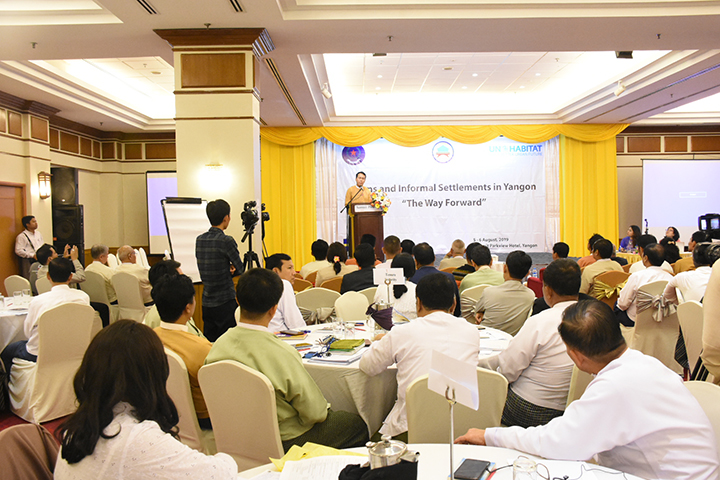The Yangon Region Government has teamed up with UN Habitat (Myanmar) to find sustainable solutions for Yangon’s slums and informal settlements, where over 500,000 people are experiencing obstacles for dwelling.
“We need to draw short-term and long-term plans for the upgrade of slums,” said U Phyo Min Thein, the Yangon Region Chief Minister, at a recently concluded workshop on Slums and Informal Settlements in Yangon Region, and he promised to find ways to provide job opportunities, income, education, and healthcare to slum dwellers.
As a possible short term solution, the Yangon government plans to arrange for low-cost housing zones and basic infrastructure.
The Chief Minister also emphasized the long term solution will look at relocation as a possible solution for the most vulnerable slum dwellers. Speaking at the event, U Min Htein, the Director General of the Department of Urban and Housing Development (DUHD), Ministry of Construction, highlighted the need to find sustainable solutions for the slum dwellers living in informal settlement areas in Yangon with proper planning in line with rules and regulations.
The Country Programme Manager of UN-Habitat Myanmar, Mr Bijay Karmacharya called for addressing the problem of informal settlements in the city. He also dwelt on the universally recognized means of solutions to informal settlements, emphasizing that all were in agreement that eviction is no longer a solution.
The two-day workshop, which was jointly conducted by the the Yangon Region Government, Urban and Housing Development Department, and UN-Habitat, took place at the Summit Parkview Hotel in Yangon. A comprehensive mapping exercise conducted by the UN-Habitat in 2016 identified a total of 423 informal settlements in Yangon, the country’s most populated city. The settlements are spread over more than 1,800 acres, or approximately 1.23 per cent of Yangon’s total land area, and house an estimated 365,000 people, or between 6-8 per cent of the city’s total population.
The study noted that 270 of the 423 identified settlements were formed between January, 2010 and July, 2016, primarily in response to the migration from the Delta region post Cyclone Nargis and increased employment opportunities.
About 15 million people, or about 30 per cent of Myanmar’s population aged over 51, are living in urban areas.
The figure is expected to increase rapidly: projections indicate that an additional 7.1 million of the current rural population will migrate to cities by 2050.
The Yangon Region Government has issued smart cards to over 150,000 households. — San Kyaw Oo (IPRD)
(Translated by La Wonn)


